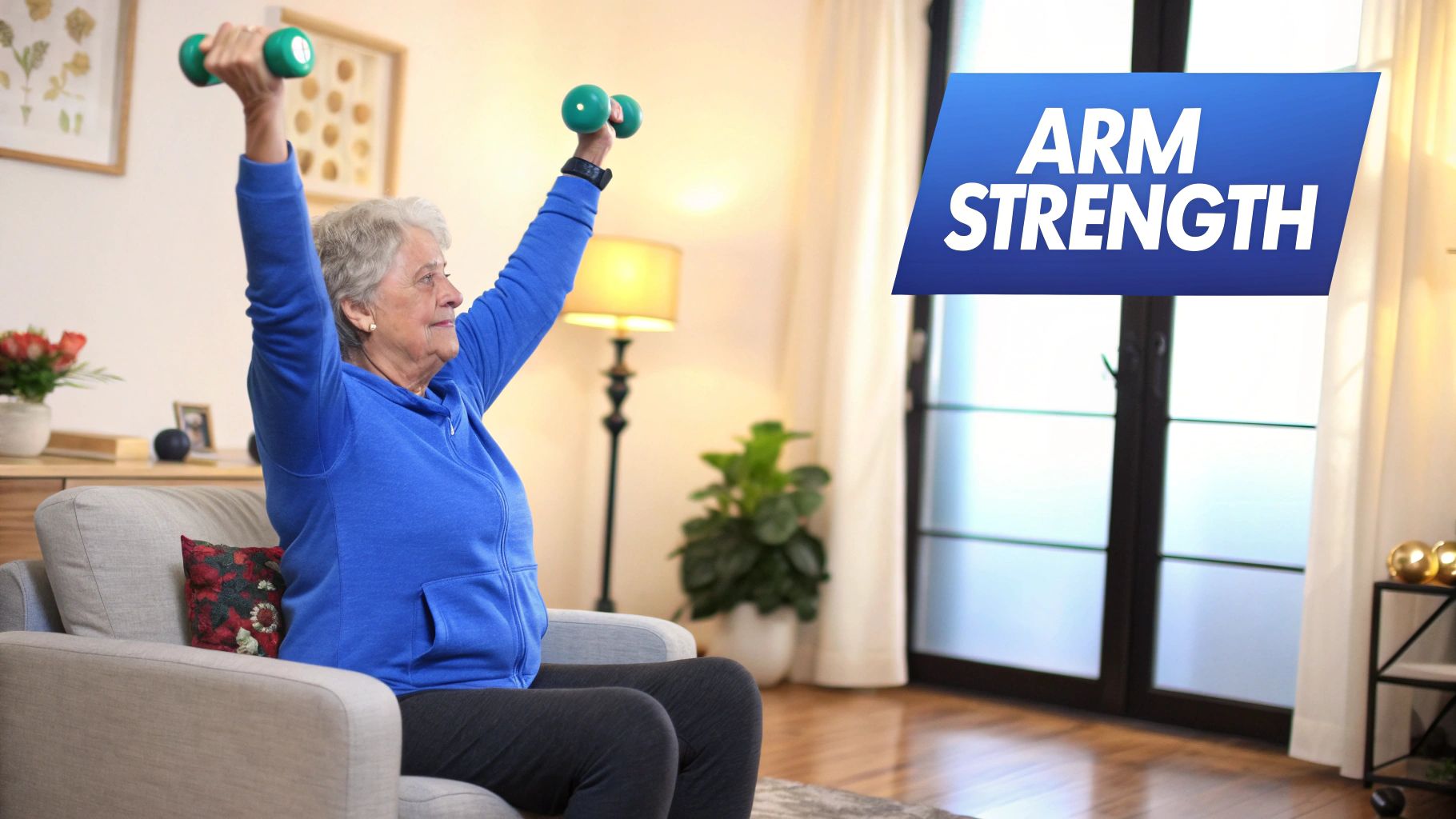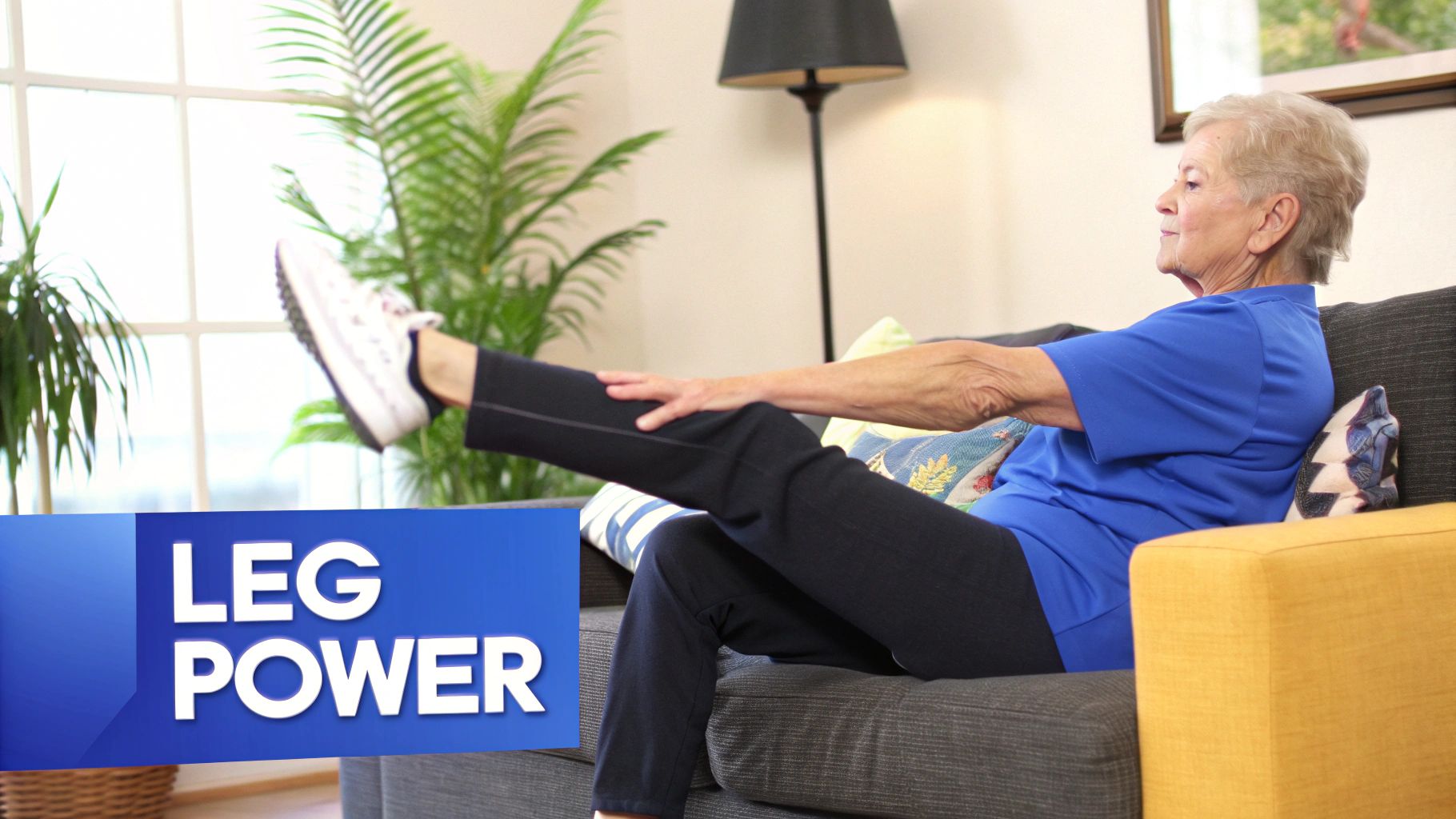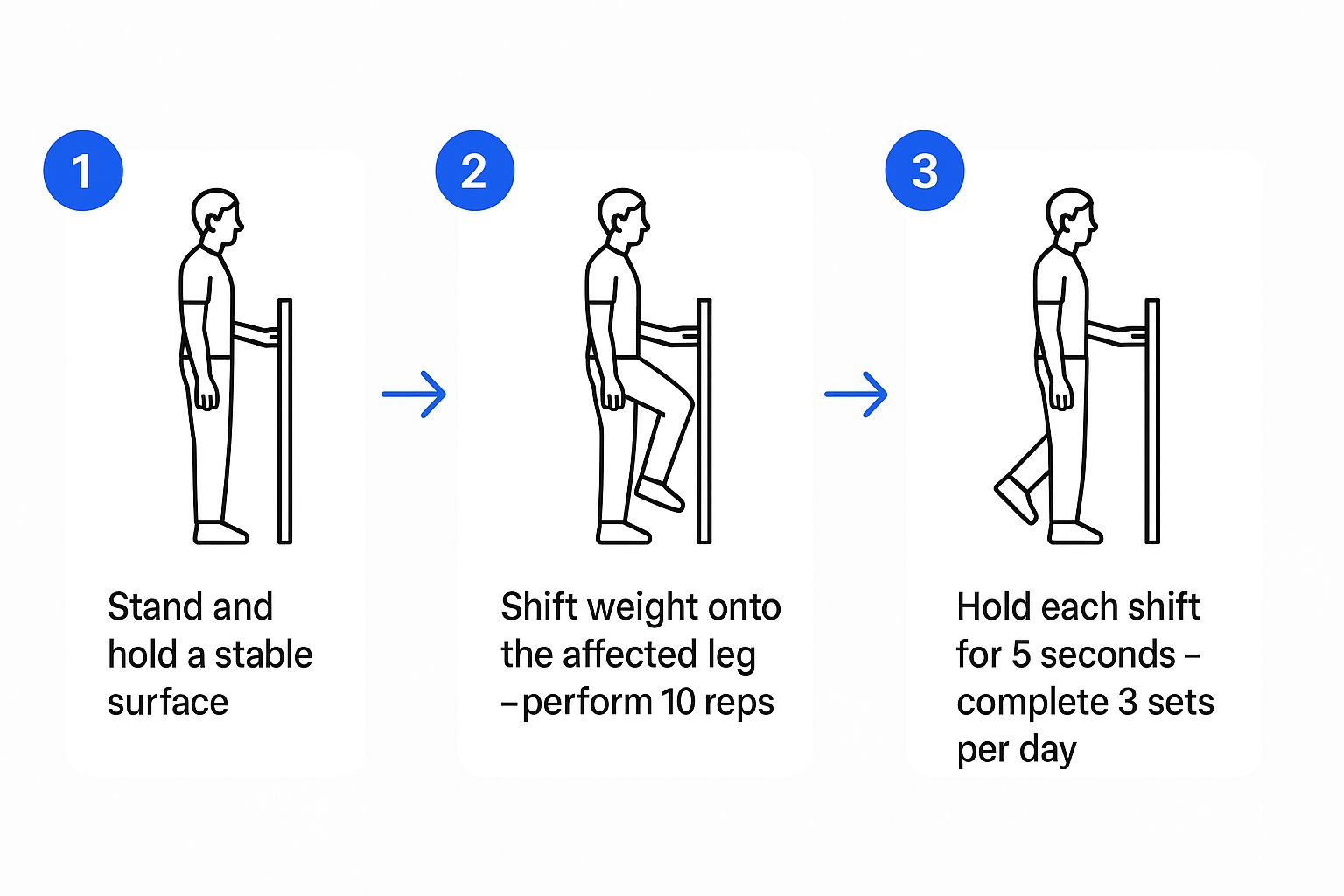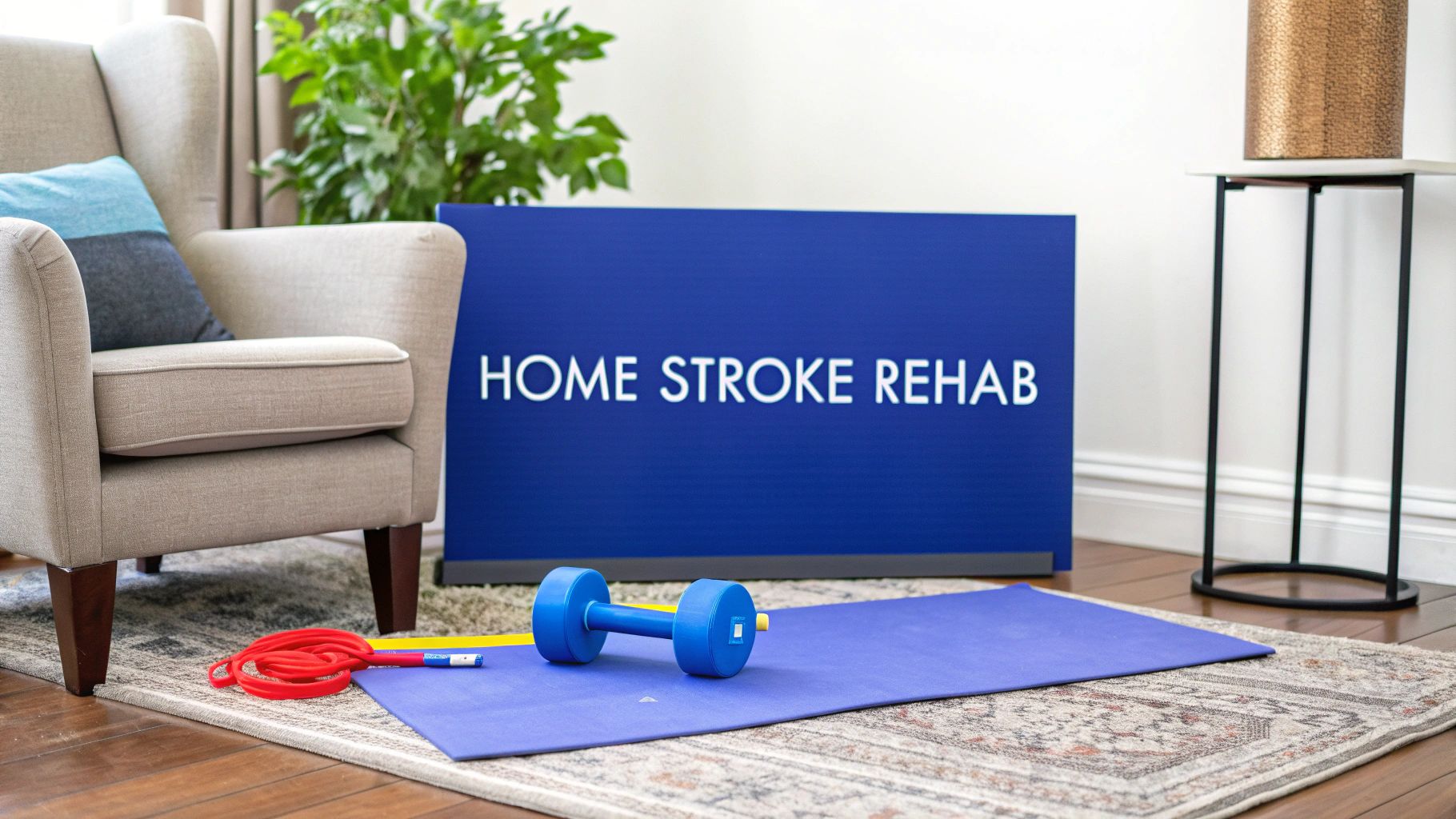Taking an active role in your own recovery with stroke recovery exercises at home is one of the most powerful things you can do. When you commit to a consistent, safe routine, these exercises are proven to help you regain mobility, build back strength, and improve your quality of life—all from the comfort of home.
Starting Your Home Recovery Journey Safely
Beginning a home exercise program after a stroke can feel like a huge step. It’s exciting, for sure, but it can also be a little nerve-wracking. That’s completely normal. The most important thing to do before you start anything is to get the green light from your healthcare team.
You absolutely must consult your doctor, physical therapist, or occupational therapist before trying any new exercises. They know your specific situation—which parts of the brain were affected, your current physical limits, and what movements are safest for you. They can give you a personalized plan and clear safety guidelines that are made just for you.
Think of your therapist as your most valuable partner in this process. They can show you how to modify exercises, help you set achievable goals, and make sure you’re doing every movement correctly to avoid injury and get the most out of neuroplasticity—the brain's incredible ability to rewire itself.
Before you jump into any routine, it's critical to run through a quick safety check. This simple step minimizes risk and ensures your exercise space is ready for you.
Safety First Checklist for Home Exercises
Here’s a quick-reference table to help you prepare. Go through these points before each session to create a safe and effective environment for your recovery.
| Safety Check | Why It's Important | Action Item |
|---|---|---|
| Get Medical Clearance | Your healthcare team knows your specific needs and limitations, preventing potential injury. | Talk to your doctor, PT, or OT before starting any new exercise program. |
| Clear Your Space | A cluttered area increases the risk of tripping and falling, especially with balance challenges. | Remove rugs, cords, and furniture from your exercise area. Ensure good lighting. |
| Have Support Nearby | Having a sturdy surface or another person available provides stability and immediate help if needed. | Exercise near a wall, a sturdy chair, or have a family member or caregiver present. |
| Listen to Your Body | Pushing through pain can lead to injury or setbacks. Fatigue is a real factor post-stroke. | Stop immediately if you feel sharp pain, dizziness, or shortness of breath. Rest when you feel tired. |
| Stay Hydrated | Dehydration can cause dizziness and fatigue, affecting your performance and safety. | Keep a water bottle nearby and drink before, during, and after your session. |
This checklist isn't just a list of rules; it's a framework for building confidence. By taking these simple precautions, you empower yourself to focus on what really matters: your movement and your progress.
The Power of a Structured Home Routine
It’s tempting to just do a few exercises here and there, but a structured routine is where the real magic happens. Consistency is what tells your brain to forge new neural pathways, which is how you restore function to the parts of your body affected by the stroke.
This isn't just a hopeful idea; it's backed by solid science. For example, a 2021 study found that stroke survivors who stuck with a structured home exercise program saw major improvements in their ability to live independently. The research showed that a well-designed plan at home can be just as good as going to outpatient therapy. You can learn more about these promising findings by reviewing the study.
This guide is meant to support the advice from your therapist, not replace it. The exercises we'll cover are based on the real-world experiences of survivors and the practical wisdom of therapists. By committing to a consistent and safe home program, you aren’t just moving your body—you’re actively rebuilding your life, one small, intentional step at a time.
Foundational Exercises for Core Stability and Balance
Think of your body like a building. You can't start hanging pictures or moving in furniture until you have a solid foundation. In stroke recovery, your core strength and balance are that foundation. Every single movement you make, whether it's standing up from a chair or just reaching for the remote, originates from a stable center. If you skip this step, it's easy to get frustrated when other movements don't come as easily as you'd hoped.
These foundational stroke recovery exercises at home are all about being gentle but effective. We’re focusing on waking up those deep muscles in your trunk and pelvis that give you stability. You won't need any special equipment for these—just a sturdy, armless chair. The key here is to move slowly and with intention.
Gentle Seated Core Activations
Let's begin with a few movements you can do safely right from your chair. Find a firm one where you can plant your feet flat on the floor. Scoot forward a bit, sitting up tall away from the backrest. This simple act of sitting tall already starts to engage your core.
-
Pelvic Tilts: Picture your pelvis as a bowl full of water. First, gently tilt it forward as if you're trying to spill water out the front. You'll feel a small arch in your lower back. Hold that for three seconds. Now, slowly tilt it backward, like you're spilling water out the back, which will flatten your lower back. This tiny movement is incredibly powerful for re-establishing core control. Aim to repeat this 10 times.
-
Seated Marching: Keeping your upper body as still as a statue, slowly lift one foot just an inch or two off the floor. Hold it there for a moment, then lower it back down with complete control. Alternate legs, almost like you're marching in super slow motion. This challenges your core to keep you from swaying from side to side. Try for 10-15 lifts per leg.
These simple seated exercises are your first step in rebuilding that crucial mind-muscle connection, which you'll need for more complex activities down the road.
Building Stability with Weight Shifts
Once you feel more confident and steady with the seated work, you can move on to exercises that involve shifting your weight. This skill is directly linked to improving your balance for standing and walking. Always, always do these next to a sturdy surface you can hold onto, like a kitchen counter or the back of a heavy sofa.
A common mistake I see is people rushing through balance exercises. The goal isn't speed; it's control. Holding that slightly off-balance position is what forces your brain and muscles to coordinate and keep you upright. That’s the real work that helps reduce the risk of falls.
Controlled Weight Shifts (Standing):
- Stand with your feet about hip-width apart, holding onto your support surface for safety.
- Slowly and deliberately shift your weight onto your more affected leg. Don’t lift your other foot completely off the ground yet—just make it light.
- Hold this position for 5-10 seconds, focusing on keeping your posture tall and your core tight.
- Gently shift your weight back to the center, then repeat on your less-affected leg and hold.
- Continue this side-to-side shifting motion 10 times.
As you get stronger, you can challenge yourself by lifting the unweighted foot completely off the floor for a few seconds. Every repetition helps your brain relearn how to manage its center of gravity. For more one-on-one support, in-home care services can be a huge help in guiding you through these routines safely. You can get a better sense of how this works by reviewing this helpful guide on caregiver support.

Being consistent with these core and balance exercises is what builds the stable base you need for every other aspect of your recovery journey.
Exercises To Rebuild Lower Body Strength And Mobility

Regaining strength and control in your legs is a huge part of reclaiming your independence after a stroke. From the simple act of standing up from a chair to walking through your home, your lower body is what gives you the power and stability you need for daily life. These stroke recovery exercises at home are designed to meet you exactly where you are, whether you're just starting in bed or are ready to try standing with a bit of support.
The real key to success here is focusing on safe, steady progress. Believe me, it’s far better to do just a few repetitions with good, solid form than to rush through a bunch with poor technique. Safety is always number one, so make sure you have a sturdy surface like a wall or the kitchen counter within arm's reach for support during any standing exercises.
Foundational Leg Movements
Let’s start with some gentle exercises you can do while lying down or sitting. These movements target the key muscle groups in your hips and legs, helping re-establish that crucial brain-body connection without putting a lot of stress on your joints.
-
Heel Slides: While you're lying on your back in bed, slowly slide the heel of your affected leg up toward your buttocks. Just bend your knee as much as you comfortably can. Hold it for a second, and then slowly slide it back down. This is a fantastic, simple motion for hip and knee flexibility.
-
Leg Lifts (Lying Down): From that same position on your back, keep your affected leg as straight as you can and slowly lift it just a few inches off the bed. The goal is all about control, not how high you can go. Hold it for three seconds, then lower it back down with that same deliberate control. This one is essential for building hip flexor strength.
-
Seated Knee Extensions: Sit up tall in a firm chair, with your feet flat on the floor. Slowly straighten your affected leg, lifting your foot until your knee is as straight as you can manage. Squeeze your thigh muscle at the top, then slowly lower your foot back to the floor.
Remember, consistency trumps intensity, especially in the beginning. The goal is to consistently send signals from your brain to your leg muscles. That repetition is exactly what helps rebuild and strengthen those crucial neural pathways.
Progressing To Standing Exercises
Once you start to feel more stable—and you have the green light from your therapist—you can move on to weight-bearing exercises. These are absolutely vital for improving how you walk, building up your endurance, and really boosting your confidence.
Supported Sit-to-Stands:
This is easily one of the most functional and important exercises you can do. Stand right in front of a sturdy chair. Use a countertop or another heavy, stable piece of furniture for hand support. With as much control as you can muster, slowly lower yourself down into the chair. Then, push through your heels to stand back up. Try to focus on using your leg strength instead of pulling yourself up with your arms. A good goal is 5-10 repetitions.
The power of home-based programs like this is well-supported. For instance, a 2016 study found that an incredible 52% of participants saw significant improvements in their walking speed after following a dedicated home exercise program. You can read more about the study's findings on home rehabilitation. This really shows how powerful consistent effort at home can be.
For anyone who needs a little extra guidance, having a caregiver assist with these exercises can add a much-needed layer of safety and support. You can see how that works by checking out our visual guide on in-home support.
Restoring Function with Upper Body and Arm Exercises

Getting back control of your arms and hands is a huge step toward regaining independence. Think about it—almost everything we do, from brushing our teeth to grabbing a coffee mug, depends on our upper body. These stroke recovery exercises at home are all about rebuilding that function with practical movements you can use every single day.
The best part? You don't need a fancy gym. Your own home is packed with everything you need. A kitchen table can support your arm while you practice sliding it forward, and a simple can of soup can work just as well as a lightweight dumbbell.
Starting with Gentle, Supported Movements
If you're dealing with significant weakness or even paralysis in an arm, the best place to start is with passive or active-assisted movements. This just means you'll use your stronger, unaffected arm to help guide the weaker one through each exercise. It might not feel like you're "working," but this process is critical for firing up your brain and encouraging neuroplasticity.
-
Tabletop Arm Slides: Sit at a table and place a small towel under your affected hand to help it glide. Then, put your unaffected hand over your affected one. Gently push your hands forward across the table and then pull them back. This is a great, supported way to reintroduce shoulder and elbow motion.
-
Shoulder Shrugs: Whether you're sitting or standing, try to sit up tall. Slowly lift both shoulders up toward your ears, hold for just a second, and then let them drop back down. It's a simple move, but it does wonders for shoulder stiffness and helps you reconnect with those muscles.
These first movements are all about rebuilding that mind-body connection. The goal isn't lifting heavy things; it's about sending clear, consistent messages from your brain back to your muscles.
Task-Specific Training for Real-World Skills
In my experience, the therapy that sticks is the kind that mimics the exact tasks you want to be able to do again. We call this task-specific training, and it's fantastic for helping your brain rebuild pathways for functional activities. So, instead of just doing random bicep curls, practice lifting a cup to your mouth.
Key Insight: Your brain learns best with context. Reaching for a specific object on a shelf is far more powerful for recovery than just reaching into thin air. This helps the skill translate directly into your daily life, which is the whole point.
This is where doing your rehab at home really shines. A 2022 review showed that home programs focused on daily, context-specific tasks led to better motor function and people were happier with their care compared to clinic-only therapy. The familiar setting helps your brain forge stronger connections. You can discover more about the benefits of home-based rehabilitation from the study itself.
Progressing with Light Resistance
Once your control starts to improve, you can begin adding a little bit of resistance to build up strength. Just remember, proper form is always more important than how much weight you're using.
At-Home Resistance Examples:
| Exercise | Household Item | Focus |
|---|---|---|
| Bicep Curls | A can of soup or a water bottle | Slowly bend your elbow, bringing the item toward your shoulder. |
| Side Arm Raises | A small bag of rice or beans | With a straight arm, lift the item out to your side, going no higher than your shoulder. |
Aim to start with just 5-10 repetitions of each exercise. Keep the movements slow and controlled. If you feel any sharp pain, stop right away. It's the consistency that will truly drive your progress, helping you reclaim the ability to tackle daily tasks with more confidence and ease.
How To Create Your Weekly Home Exercise Plan
Knowing the right stroke recovery exercises to do at home is a great start, but consistency is what really unlocks progress. Just doing exercises here and there won't forge the strong neural pathways your brain needs for a lasting recovery. The key is to build a structured, balanced weekly plan that turns your good intentions into real, tangible results.
A well-thought-out plan ensures you’re working all the different muscle groups without overdoing it on any single one. More importantly, it helps establish a routine that feels sustainable instead of overwhelming—and that’s absolutely critical for staying with it long-term.
Balancing Your Efforts For Maximum Gain
Think of your weekly schedule like a balanced diet. A little bit of everything is far better than too much of just one thing. You'll want to incorporate exercises from each of the categories we've covered: core and balance, lower body, and upper body. This holistic approach ensures you’re tackling both mobility and strength from all angles.
A smart way to organize this is by dedicating certain days to specific focus areas. For instance, you could concentrate on lower body strength on Monday and then switch to upper body function on Tuesday. This gives your muscle groups time to rest and repair, which is when they actually get stronger. Never underestimate the power of a rest day; it's just as vital as the exercise itself.
Your body gives you feedback every single day. Some days you'll feel full of energy, while on others, fatigue might hit you like a ton of bricks. Listening to these signals is the most important part of any recovery plan. Pushing through sharp pain or total exhaustion is just counterproductive and can easily lead to setbacks.
Setting Achievable Goals And Tracking Progress
Your goals should feel personal and, most importantly, motivating. Instead of a vague goal like "get stronger," aim for something specific you can measure. A great example is, "I want to be able to do 10 sit-to-stands without using my hands for support." This gives you a clear, concrete target to work toward.
Keeping track of your progress is one of the best ways to stay motivated, and it doesn’t have to be complicated. A simple notebook or a calendar where you jot down what you did each day works perfectly.
- Record the exercise: Note which movements you performed.
- Count your reps: Write down how many repetitions you managed for each set.
- Add a small note: How did it feel? Was it a little easier than last time? Did you feel a bit shaky?
This simple act of record-keeping lets you look back after a few weeks and see concrete proof of how far you've come. That visual evidence is an incredibly powerful motivator on those tougher days. To make it even easier, you can use a printable weekly exercise planner to map out your activities and celebrate your achievements.
Sample Weekly Stroke Recovery Exercise Schedule
To give you a clearer picture of how this all fits together, here’s a sample schedule. Remember, this is just a template—feel free to adjust the days, exercises, and durations based on your energy levels and your therapist's recommendations.
| Day | Focus Area | Example Exercises | Duration/Reps |
|---|---|---|---|
| Monday | Lower Body & Balance | Sit-to-Stands, Heel Raises, Marching in Place | 2 sets of 10-15 reps |
| Tuesday | Upper Body & Core | Wall Push-ups, Seated Trunk Twists, Arm Raises | 2 sets of 10-15 reps |
| Wednesday | Active Rest & Flexibility | Gentle Stretching, Slow Walking (if safe) | 15-20 minutes |
| Thursday | Lower Body & Balance | Leg Lifts, Tandem Stance, Weight Shifts | 2 sets of 10-15 reps |
| Friday | Upper Body & Core | Table Slides, Wrist Curls, Shoulder Rolls | 2 sets of 10-15 reps |
| Saturday | Light Activity & Functional | Light household tasks, walking with support | 15-20 minutes |
| Sunday | Full Rest Day | Rest and recover | Rest |
This structure provides a great mix of strengthening, balance work, and crucial rest, helping you make steady, sustainable progress without burning out.
This image shows a simple but highly effective balance exercise you can easily integrate into your routine.

This visual breaks down the weight-shifting exercise into clear, manageable parts, with an emphasis on control and repetition—two key principles for encouraging neuroplasticity. By following this simple flow, you can safely practice a core balance skill that translates directly to better stability when you’re standing and walking.
Answering Your Top Questions About Home Stroke Recovery
Starting a home exercise program after a stroke is a big step, and it’s completely natural for questions and a few worries to pop up. We’ve worked with countless survivors and their families, and we hear the same concerns time and again. Let's tackle some of the most common ones head-on so you can feel more confident on this journey.
One of the biggest obstacles we see is post-stroke fatigue. This isn't just feeling a bit tired; it's a deep, bone-wearying exhaustion that can show up without warning. So, how on earth are you supposed to exercise when you feel completely drained?
The trick is to learn to work with your body, not against it. Some days you’ll have the energy to get through your whole routine, and that’s fantastic. On other days, just doing a few gentle stretches while still in bed is a huge win. The goal here is consistency over intensity.
How Do I Know When to Push and When to Rest?
This is the million-dollar question. Figuring out the difference between the good kind of tired and the kind of strain that sets you back is a skill you'll develop over time.
Think of it this way: productive effort feels like your muscles are working hard or you're concentrating to keep your balance, but you're still in control. Harmful strain feels different—it might be a sharp pain, sudden dizziness, or feeling really out of breath.
A great tool we teach families is the "stoplight" method. Green light means you feel challenged, but it's manageable. A yellow light is a warning—you’re feeling a lot of strain or your form is getting sloppy. Time to slow down or stop. A red light means you're feeling sharp pain, dizziness, or extreme fatigue. You need to stop immediately.
Trusting this internal stoplight keeps you safe. Pushing through a "red light" rarely leads to progress and can easily lead to a setback or even an injury.
What If an Exercise Feels Too Hard?
It’s going to happen. You’ll encounter an exercise that just feels impossible at first. Don't let that discourage you! It doesn't mean you should give up on it; it just means you need a smart modification.
Here are a few ways you can adapt a movement that feels too challenging:
- Shrink the movement. Instead of a full sit-to-stand, just try lifting your hips an inch off the chair and sitting back down.
- Add more support. If a standing exercise feels wobbly, use both hands on a sturdy countertop instead of just one.
- Break it into pieces. Can't lift your arm all the way up? That's okay. Start with a shoulder shrug, then maybe add a small elbow bend.
Remember, every single attempt, no matter how small it seems, is helping your brain heal and build new connections. The goal isn’t perfection. It’s participation. Each movement is a step forward.
Navigating these challenges is always easier when you have an expert in your corner. NJ Caregiving offers compassionate, skilled in-home caregivers who can support you during your exercise routine, helping you stay safe and motivated. Find out more about our personalized care plans at https://njcaregiving.com.



